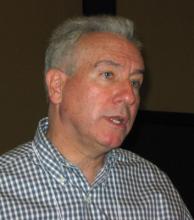SNOWMASS, COLO. – A recently identified statin-triggered, immune-mediated necrotizing myopathy needs to be considered among the possible explanations for statin-induced muscle symptoms and creatine phosphokinase elevations that persist despite discontinuation of the lipid-lowering drug.
It’s important to try to identify patients with this chronic immune-mediated disorder because they improve in response to corticosteroids or other immunosuppressive medications, Dr. Chester V. Oddis said at a symposium sponsored by the American College of Rheumatology.
This rare new entity was first described last year by physicians at Brigham and Women’s Hospital, Boston, who reported on 25 affected patients. The findings were published in a neurology journal (Muscle Nerve 2010;41:185-90), so this disorder remains as yet virtually unknown among the primary care physicians and cardiologists who prescribe statins as well as the rheumatologists who receive many referrals for statin-associated muscle symptoms, noted Dr. Oddis, professor of medicine at the University of Pittsburgh.
The key points regarding this necrotizing myopathy: It features proximal muscle weakness and an elevated creatine phosphokinase (CPK) arising during statin therapy that persist after the drug has been stopped, and a muscle biopsy showing necrosis and myophagocytosis but no significant inflammation. The lack of inflammation readily distinguishes this condition from inflammatory myopathies such as dermatomyositis and polymyositis.
Twenty-four of the 25 patients required immunosuppressive therapy with corticosteroids, methotrexate, or other agents. Fifteen of the 24 relapsed upon attempts to taper the immunosuppressive therapy, strengthening the case that this statin-triggered disorder has an immune etiology.
Subsequently, rheumatologists at Johns Hopkins University, Baltimore, reported finding an autoantibody that Dr. Oddis strongly suspects is involved in the statin-induced necrotizing myopathy described by the Brigham and Women’s Hospital team.
The Johns Hopkins group reported that muscle biopsies from 38 of 225 patients with myopathy showed myofiber necrosis without prominent inflammation. Twelve of these 38 patients had a known autoantibody association that could explain their myopathy. Sera from 16 of the remaining 26 patients immunoprecipitated a novel autoantibody recognizing 200-kD and 100-kD proteins. Patients with this doublet autoantibody had proximal weakness, a mean maximum CPK of 10,333 IU/L, and 10 of the 16 had been exposed to statins prior to onset of weakness. All responded to immunosuppressive therapy, but many of them relapsed when the treatment was tapered (Arthritis Rheum. 2010;62:2,757-66).
To put this new immune-mediated necrotizing myopathy in clinical perspective, it is a rare entity. The 25 patients in the Brigham and Women’s series were seen during an 8-year period at two neuromuscular centers. In fact, although statin-associated muscle symptoms are common, being reported in around 10% of treated patients in prospective studies, it is quite uncommon for the symptoms and/or CPK elevations to persist after drug discontinuation. Once thyroid disease and other potential drug causes of noninflammatory myopathy have been ruled out, persistent symptoms following statin discontinuation are downright rare.
Dr. Oddis said that in addition to the recently described statin-induced, immune-mediated necrotizing myopathy, the other diagnostic possibility when muscle symptoms persist following statin discontinuation is an underlying statin-triggered neuromuscular disorder.
He drew attention to a genetic mutation study conducted by investigators at the State University of New York, Buffalo, in 110 patients with lipid-lowering drug-induced myopathies and 248 controls. The number of carriers for McArdle disease or for carnitine palmityltransferase II deficiency – two of the most common metabolic myopathies – was increased 20-fold and 13-fold, respectively, in patients with myopathies associated with lipid-lowering drugs.
Moreover, muscle biopsies from 106 of the patients showed that 52% of them had significant biochemical abnormalities in mitochondrial or fatty acid metabolism, and 31% had multiple biochemical defects (Muscle Nerve 2006;34:153-62).
The implication of these findings is that some patients with statin-induced myopathy that persists after drug discontinuation have an underlying genetic susceptibility to muscle symptoms that becomes overt when they are exposed to statins. Statins are known to have an inhibitory effect upon production of muscle energy because of their inhibition of coenzyme Q production, with resultant impairment of mitochondrial function. In genetically vulnerable individuals, this statin effect on energy metabolism may be sufficient to trigger myopathy, Dr. Oddis explained.
One frustrated audience member said that most of the patients in his rheumatology practice are on a statin, and many of them complain of muscle pain and fatigue. Moreover, elevated CPK is common for reasons unrelated to statin therapy. The prospect of performing muscle biopsies in everyone he sees with persistent muscle symptoms and/or CPK elevation after statin discontinuation is daunting. Can MRI be used as alternative means of distinguishing patients with an inflammatory versus a noninflammatory myopathy? he asked.


